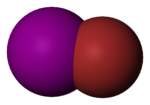Iodine monobromide
Appearance

| |

| |
| Names | |
|---|---|
| IUPAC name
Iodine monobromide
| |
| Other names
Iodine bromide
| |
| Identifiers | |
3D model (JSmol)
|
|
| ChemSpider | |
| ECHA InfoCard | 100.029.236 |
PubChem CID
|
|
CompTox Dashboard (EPA)
|
|
| |
| |
| Properties | |
| IBr | |
| Molar mass | 206.904 g/mol |
| Appearance | dark red solid |
| Melting point | 42 °C (108 °F; 315 K) |
| Boiling point | 116 °C (241 °F; 389 K) |
| Related compounds | |
Other anions
|
iodine monochloride, iodine monofluoride |
Related interhalogen compounds
|
Iodine monochloride Iodine monofluoride Bromine monochloride |
Except where otherwise noted, data are given for materials in their standard state (at 25 °C [77 °F], 100 kPa).
| |
Iodine monobromide is an interhalogen compound with the chemical symbol IBr. It is a dark red solid that melts near room temperature. Like iodine monochloride, IBr is used in some types of iodometry. It serves as a source of I+.
Synthesis
Iodine monobromide is formed when iodine and bromine are combined:[1]
- I2 + Br2 → 2 IBr
References
- ^ Greenwood, Norman N.; Earnshaw, Alan (1997). Chemistry of the Elements (2nd ed.). Butterworth-Heinemann. ISBN 978-0-08-037941-8.
